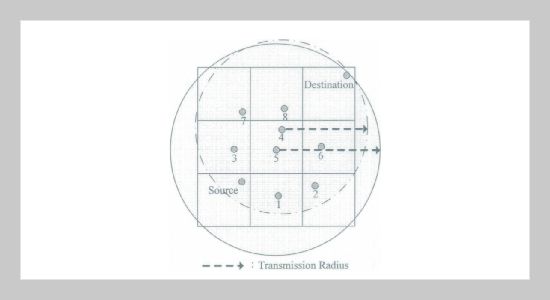REFERENCES
- [1] Crow, B. P., Widjaja I., Kim L. G. and Sakai P. T., “IEEE 802.11 Wireless Local Area Networks,” IEEE Communications Magazine, Vol. 35, pp. 116�126 (1997).
- [2] Ververidis, C. N. and Polyzos, G. C., “Service Discovery for Mobile Ad Hoc Networks: A Survey of Issues and Techniques,” IET Communications, Vol. 10, pp. 30�45 (2008).
- [3] Junhai, L., Danxia, Y., Liu, X. and Mingyu, F., “A Survey of Multicast Routing Protocols for Mobile AdHoc Networks,” IEEE Communications Surveys and Tutorials, Vol. 11, pp. 78�91 (2009).
- [4] Lima, M., Dos, S. A. and Pujolle, G., “ASurvey of Survivability in Mobile Ad Hoc Networks,” IEEE Communications Surveys and Tutorials, Vol. 11, pp. 66�77 (2009).
- [5] Younis, M. and Ozer, S. Z., “Wireless Ad-Hoc Networks: Technologies and Challenges,” Wireless Communication Mobile Computing, Vol. 6, pp. 889�892 (2006).
- [6] Pelusi, L., Passarella, A. and Conti, M., “Opportunistic Networking: Data Forwarding in Disconnected Mobile Ad Hoc Networks,” IEEE Communications Magazine, Vol. 44, pp. 134�141 (2006).
- [7] Ramanathan, R. and Redi, J., “A Brief Overview of Ad Hoc Networks: Challenges and Directions,” IEEE Communication Magazine, Vol. 40, pp. 20�22 (2002).
- [8] Abusalah, L., Khokhar, A. and Guizani, M., “A Survey of Secure Mobile Ad Hoc Routing Protocols,” IEEE Communications Surveys and Tutorials, Vol. 10, pp. 78�93 (2008).
- [9] Li, F. and Wang, Y., “Routing in Vehicular Ad Hoc Networks: A Survey,” IEEE Vehicular Technology Magazine, Vol. 2, pp. 12�22 (2007).
- [10] Liang, O., Sekercioglu, Y. A. and Mani, N., “A Survey of Multipoint Relay Based Broadcast Schemes in Wireless Ad Hoc Networks,” IEEE Communications Surveys and Tutorials, Vol. 8, pp. 30�46 (2006).
- [11] Chen, L. and Heinzelman, W. B., “A Survey of Routing Protocols that Support QoS in Mobile Ad Hoc Networks,” IEEE Network, Vol. 21, pp. 30�38 (2007).
- [12] Perkins, C. E. and Royer, E. M., “Ad Hoc on Demand Distance Vector Routing,” 1999 Mobile Computing Systems and Applications Conference, LA, USA, IEEE, p. 90�100 (1999).
- [13] Johnson, D. B. and Maltz, D. A., Dynamic Source Routing Protocol in Ad Hoc Networks, In: Imielinski T., Korth H. editor. Mobile Computing, 1st ed. London: Sprinker, p. 153�181 (1996).
- [14] Li, J., Cordes, D. and Zhang, J., “Power-Aware Routing Protocols in Ad Hoc Wireless Networks,” IEEE Wireless Communications, Vol. 12, pp. 69�81 (2005).
- [15] Zhang, B. and Mouftah, H. T., “Energy-Aware OnDemand Routing Protocols for Wireless Ad Hoc Networks,” Wireless Networks, Vol. 12, pp. 481�494 (2006).
- [16] Panichpapiboon, S., Ferrari, G. and Tonguz, O. K., “Optimal Transmit Power in Wireless Sensor Networks,” IEEE Transactions on Mobile Computing, Vol. 5, pp. 1432�1447 (2006).
- [17] Vassileva, N. and Barcelo-Arroyo, F., “A Survey of Routing Protocols for Energy Constrained Ad Hoc Wireless Networks,” 2008 Future Generation Communication and Networking Conference, Jeju-Island, Korea, IEEE, pp. 522-527 (2008).
- [18] Liao, W.-H., Tseng, Y.-C. and Sheu, J.-P., “GRID: A Fully Location-Aware Routing Protocol for Mobile Ad Hoc Networks,” Telecommunication Systems, Vol. 18, pp. 37�60 (2001).
- [19] Tseng, Y. C. and Hsieh, T.-Y., “Fully Energy-Aware and Location-Aware Protocols for Wireless Multihop Ad Hoc Networks,” 2002 Computer Communications and Networks Conference, Florida, USA, IEEE, pp. 608�613 (2002).
- [20] Tseng, Y.-C. and Hsieh, T.-Y., “An Architecture for Power-Saving Communications in a Wireless Mobile Ad Hoc Network Based on Location Information,” Microprocessors and Microsystems, Vol. 28, pp. 457� 465 (2004).
- [21] Wu, Y.-C. and Tuan, C.-C., “Energy Saving CacheBased Routing Protocol in Wireless Ad Hoc Networks,” 2007 Wireless, Mobile and Sensor Networks Conference, Shanghai, China, IET, pp. 466�469 (2007).
- [22] Wu, Y.-C. and Tuan, C.-C., “Power Saving Routing Protocol with Power Sieving in Wireless Ad Hoc Networks,” 2009 Networks Security, Wireless Communications and Trusted Computing Conference, Wuhan, China, IEEE, pp. 349�352 (2009).
- [23] Wu, Y.-C. and Tuan, C.-C., “Triangular Energy Saving Routing Protocol with Energy Sieving in Wireless Ad Hoc Networks,” 2009 Mobile Data Management Systems, Service and Middleware Conference, Taipei, Taiwan, IEEE, pp. 474�477 (2009).
- [24] Wu, Z., Song, H., Jiang, S. and Xu, X., “Energy-Aware Grid Multipath Routing Protocol in MANET,” 2007 Asia Modelling and Simulation Conference, Phuket, IEEE, pp. 36�41 (2007).
- [25] Wu, Z., Song, H., Jiang, S. and Xu, X., “A Grid-Based Stable Routing Algorithm in Mobile Ad Hoc Networks,” 2007 Modelling and Simulation Conference, Phuket, Thailand, IEEE, pp. 181�186 (2007).
- [26] Wu, Z., Dong, X. and Cui, L., “A Grid-Based Energy Aware Node-Disjoint Multipath Routing Algorithm for MANETs,” 2007 Natural Computation Conference, Haikou China, IEEE, pp. 244�248 (2007).
- [27] Liu, H.-I. and Yen, P.-C., “LB2R: A Load Balanced and Location Based Routing Protocol for Ad Hoc Networks,” 2004 Vehicular Technology Conference, LA, USA, IEEE, pp. 3970�3974 (2004).
- [28] Stojmenovic, I. and Lin, X., “Power Aware Localized Routing in Wireless Networks,” IEEE Transactions on Parallel and Distribution Systems, Vol. 12, pp. 1122� 1133 (2001).
- [29] Gomez, J., “Conserving Transmission Power in Wireless Ad Hoc Networks,” 2001 Network Protocols Conference, California, USA, IEEE, pp. 24�34 (2001).









